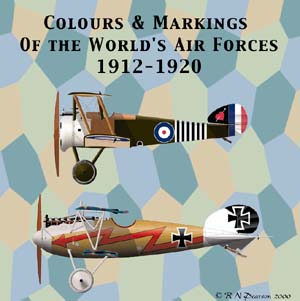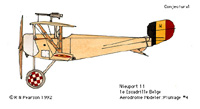 Colours &
Markings of the World's Air Forces 1912-1920
Colours &
Markings of the World's Air Forces 1912-1920
Published By R N Pearson, ©2000
Available direct from the Publisher
$40.00US ($60CDN, £25GBP)
Reviewed by Chris Banyai-Riepl
If you're interested in aircraft of the First World War, you likely know that many of them carried some very interesting color schemes (well, not the British, but everyone else did). With the beginnings of aviation only a few years before, flight in combat got its start in World War One, which also managed to quickly advance aerial technology. There's nothing like a war to advance science!
With the slow speeds of early aviation, it was a natural assumption for planes to be used as artillery spotters and observation. It wasn't until later that the idea of mounting guns came about, but when it did, airplane technology rapidly increased, both in speed and maneuverability. By the end of the war, giant bombers and snappy fighters filled the air on both sides, bringing about the development of tactics and strategies that are still used today.
 This CD takes
you on a visual feast of this lively era, from the very earliest observation
planes of 1912 to the fast fighters & bombers of 1920. The CD is broken
down into countries and include Austria-Hungary, Belgium, Commonwealth,
France, Germany, Italy, Poland, Russia, Soviet Union, and the United States.
While it does say "World's Air Forces", China and Japan are
not present (although they didn't have much in the way of aviation in
those early years).
This CD takes
you on a visual feast of this lively era, from the very earliest observation
planes of 1912 to the fast fighters & bombers of 1920. The CD is broken
down into countries and include Austria-Hungary, Belgium, Commonwealth,
France, Germany, Italy, Poland, Russia, Soviet Union, and the United States.
While it does say "World's Air Forces", China and Japan are
not present (although they didn't have much in the way of aviation in
those early years).
 Once you
go to a certain country's page, you'll find a complete listing of every
squadron for that country. A click on the squadron brings up a page with
all the planes flown by that squadron. While Mr. Pearson has profiled
a HUGE number of aircraft (over 1200 are on this CD), there is bound to
be one or two that he missed. Good luck in finding which ones they are,
though! For each profile presented, you are presented with the aircraft
type and serial (for instance, Albatros D.III (OEF) 53.46), the pilot
(Hptm Johann Frint), the date (February 1918), and the references used
(Air Aces of the A-H Empire). The example given above is that from Flik
27 of the A-H empire.
Once you
go to a certain country's page, you'll find a complete listing of every
squadron for that country. A click on the squadron brings up a page with
all the planes flown by that squadron. While Mr. Pearson has profiled
a HUGE number of aircraft (over 1200 are on this CD), there is bound to
be one or two that he missed. Good luck in finding which ones they are,
though! For each profile presented, you are presented with the aircraft
type and serial (for instance, Albatros D.III (OEF) 53.46), the pilot
(Hptm Johann Frint), the date (February 1918), and the references used
(Air Aces of the A-H Empire). The example given above is that from Flik
27 of the A-H empire.
There are two styles of profiles on this CD, as can be seen by the above examples. The first, and most numerous, are the watercolor examples like the Belgian Nieuport 11. The second are more detailed, but fewer in number (for now) and are computer-generated. Both have excellent amounts of detailing and you should have no problems in finding that interesting paint scheme for your latest WWI model. Well, you may have one problem. The CD is organized according to country and squadron, which means you'll have to know who flew what as far as planes go. You can't pop open the CD and find all the SPAD XIs, for example. However, given the large number of illustrations present it is understandable that this wasn't included. Perhaps in a future release.
Overall this is an outstanding piece of reference material for the early years of aviation and no library should be without it. Whether you're a WWI lover or not, the history and wonderful colors make this an excellent addition to anyone's collection.




